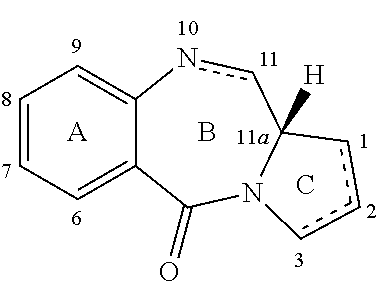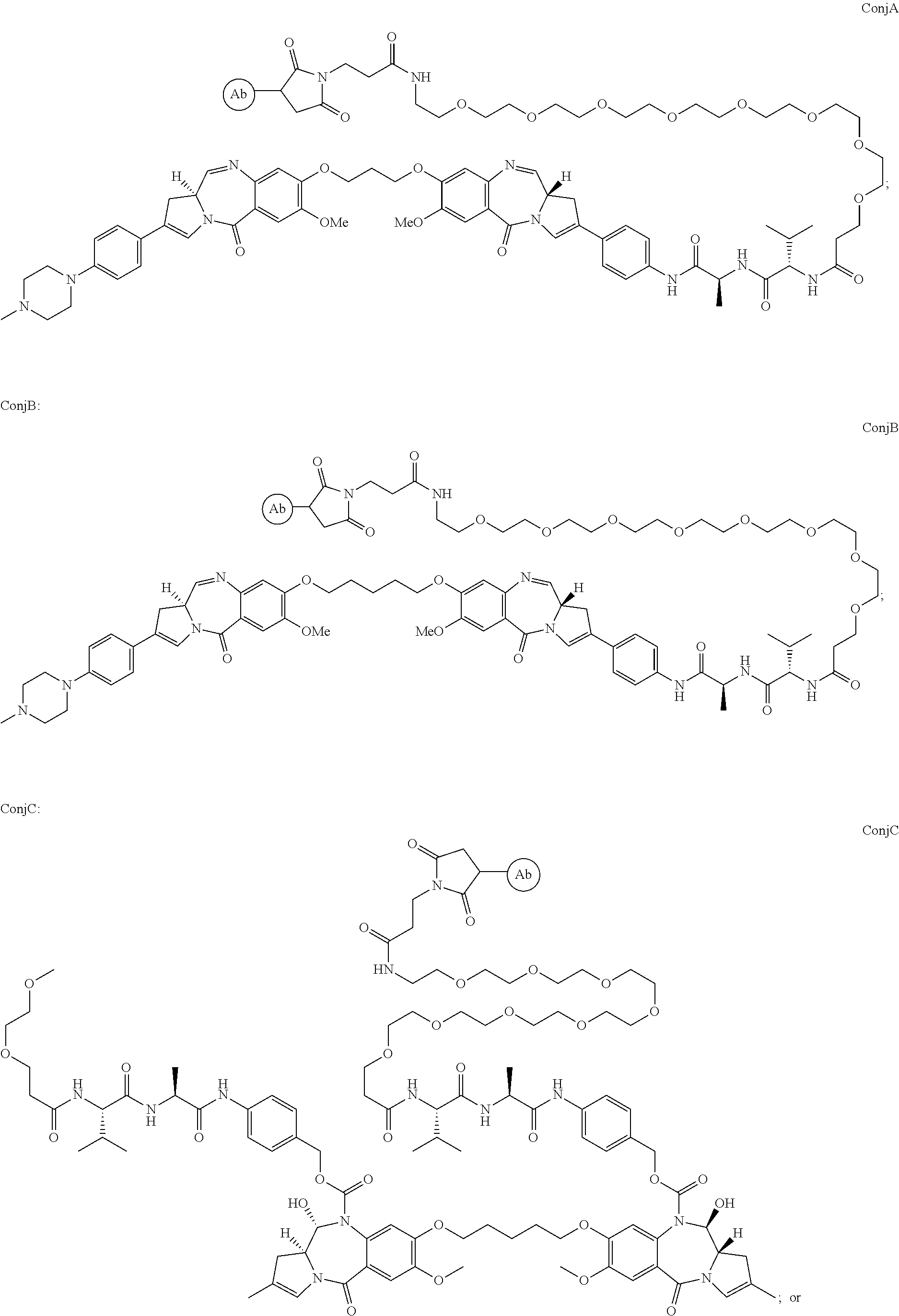Pyrrolobenzodiazepine-antibody conjugates
a technology of pyrrolobenzodiazepine and conjugates, which is applied in the direction of pharmaceutical non-active ingredients, organic active ingredients, drug compositions, etc., can solve the problems of unacceptable levels of toxicity to normal cells, and achieve the effect of strong binding
- Summary
- Abstract
- Description
- Claims
- Application Information
AI Technical Summary
Benefits of technology
Problems solved by technology
Method used
Image
Examples
embodiments
[0063]Embodiments of the present invention include ConjA wherein the antibody is as defined above.
[0064]Embodiments of the present invention include ConjB wherein the antibody is as defined above.
[0065]Embodiments of the present invention include ConjC wherein the antibody is as defined above.
Drug Loading
[0066]The drug loading is the average number of PBD drugs per antibody, e.g. antibody. Where the compounds of the invention are bound to cysteines, drug loading may range from 1 to 8 drugs (DL) per antibody, i.e. where 1, 2, 3, 4, 5, 6, 7, and 8 drug moieties are covalently attached to the antibody. Compositions of conjugates include collections of antibodies, conjugated with a range of drugs, from 1 to 8. Where the compounds of the invention are bound to lysines, drug loading may range from 1 to 80 drugs (DL) per antibody, although an upper limit of 40, 20, 10 or 8 may be preferred. Compositions of conjugates include collections of antibodies, conjugated with a range of drugs, from...
example 1
[0185]
(a) (S)-7-methoxy-8-(3-(((S)-7-methoxy-2-(4-(4-methylpiperazin-1-yl)phenyl)-5,11-dioxo-10-((2-(trimethylsilyl)ethoxy)methyl)-5,10,11,11a-tetrahydro-1H-pyrrolo[2,1-c][1,4]benzodiazepin-8-yl)oxy)propoxy)-5,11-dioxo-10-((2-(trimethylsilyl)ethoxy)methyl)-5,10,11,11a-tetrahydro-1H-pyrrolo[2,1-c][1,4]benzodiazepin-2-yl trifluoromethanesulfonate 6)
[0186]Pd(PPh3)4 (20.6 mg, 0.018 mmol) was added to a stirred mixture of the bis-enol triflate 12 (500 mg, 0.44 mmol), N-methyl piperazine boronic ester (100 mg, 0.4 mmol), Na2CO3 (218 mg, 2.05 mmol), MeOH (2.5 mL), toluene (5 mL) and water (2.5 mL). The reaction mixture was allowed to stir at 30° C. under a nitrogen atmosphere for 24 hours after which time all the boronic ester has consumed. The reaction mixture was then evaporated to dryness before the residue was taken up in EtOAc (100 mL) and washed with H2O (2×50 mL), brine (50 mL), dried (MgSO4), filtered and evaporated under reduced pressure to provide the crude product. Purification ...
example 2
Alternative Synthesis of Compound 17
[0191]
(a) 8-(3-((2-(4-((S)-2-((S)-2-((((9H-fluoren-9-yl)methoxy)carbonyl)amino)-3-methylbutanamido)propanamido)phenyl)-7-methoxy-5,11-dioxo-10-((2-(trimethylsilyl)ethoxy)methyl)-5,10,11,11a-tetrahydro-1H-benzo[e]pyrrolo[1,2-a][1,4]diazepin-8-yl)oxy)propoxy)-7-methoxy-5,11-dioxo-10-((2-(trimethylsilyl)ethoxy)methyl)-5,10,11,11a-tetrahydro-1H-benzo[e]pyrrolo[1,2-a][1,4]diazepin-2-yl trifluoromethanesulfonate (21)
[0192]Bis-triflate 12 (2.03 g, 1.81 mmol), boronic pinacol ester 20 (1 g, 1.63 mmol) and Na2CO3 (881 mg, 8.31 mmol) were dissolved in a mixture of toluene / MeOH / H2O, 2:1:1 (40 mL). The reaction flask was purged and filled with argon three times before tetrakis(triphenylphosphine)palladium(0) (41 mg, 0.035 mmol) was added and the reaction mixture heated to 30° C. overnight. The solvents were removed under reduce pressure and the residue was taken up in H2O (100 mL) and extracted with EtOAc (3×100 mL). The combined organics were washed with bri...
PUM
| Property | Measurement | Unit |
|---|---|---|
| volume | aaaaa | aaaaa |
| doubling time | aaaaa | aaaaa |
| doubling time | aaaaa | aaaaa |
Abstract
Description
Claims
Application Information
 Login to View More
Login to View More - R&D
- Intellectual Property
- Life Sciences
- Materials
- Tech Scout
- Unparalleled Data Quality
- Higher Quality Content
- 60% Fewer Hallucinations
Browse by: Latest US Patents, China's latest patents, Technical Efficacy Thesaurus, Application Domain, Technology Topic, Popular Technical Reports.
© 2025 PatSnap. All rights reserved.Legal|Privacy policy|Modern Slavery Act Transparency Statement|Sitemap|About US| Contact US: help@patsnap.com



